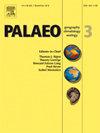盐度对中国西北部巴丹吉林沙漠湖泊沉积物中正烷烃的影响:对古气候重建的影响
IF 2.6
2区 地球科学
Q2 GEOGRAPHY, PHYSICAL
Palaeogeography, Palaeoclimatology, Palaeoecology
Pub Date : 2024-10-22
DOI:10.1016/j.palaeo.2024.112571
引用次数: 0
摘要
湖泊沉积物中的正烷烃是古气候研究的重要生物标志物,但湖泊盐度对其分布的影响仍不清楚。本研究通过分析巴丹吉林沙漠八个湖泊的沉积物来研究这种关系,这些湖泊的气候条件相似,但盐度不同。研究人员收集了湖岸植被带的土壤样本和悬浮颗粒物质 (SPM),以确定湖泊沉积物中植物输入的来源。此外,还收集了从沿岸带到湖心的所有沉积物样本,以评估不同水深的盐度影响。研究了正构烷烃的含量、水生大型植物比例(Paq)、平均链长(ACL)和碳偏好指数(CPI)等关键指标,以阐明盐度效应。结果表明,周围植被带是湖泊沉积物中正烷烃的主要来源,而 SPM 的贡献极小。盐度升高会降低沿岸带的 CPI,同时也会降低 Paq,增加湖底沉积物中的 ACL。沉积物中 Paq、ACL 和 CPI 的变化与植被带输入量的变化无关,而是表明高盐度增强了正烷烃的降解,尤其有利于湖底沉积物中中链化合物的降解。因此,正烷烃指数作为深湖岩心中水生大型植物指标的可靠性可能会受到盐度的影响。这项研究强调了利用正构烷烃重建古气候时考虑盐度影响的重要性,并表明正构烷烃作为湖泊盐化指标的潜力值得进一步关注。本文章由计算机程序翻译,如有差异,请以英文原文为准。
Salinity impacts on n-alkanes in lake sediments of the Badain Jaran Desert, Northwestern China: Implications for paleoclimate reconstruction
n-Alkanes in lake sediments are essential biomarkers for paleoclimate research, yet the influence of lake salinity on their distribution remains unclear. This study investigates this relationship by analyzing sediments from eight lakes in the Badain Jaran Desert, all subject to similar climatic conditions but varying in salinity. Soil samples from the shoreline vegetation belt and suspended particle matter (SPM) were collected to identify the origin of plant input in the lake sediments. Additionally, sediment samples from the littoral zone to the lake center were all gathered to evaluate the salinity effects at different water depths. Key indexes such as content, the proportion of aquatic macrophyte (Paq), average chain length (ACL), and carbon preference index (CPI) of n-alkanes were examined to elucidate salinity effects. The result showed that the surrounding vegetation belt is the primary source of n-alkanes in lake sediments, with minimal contributions from SPM. Increased salinity was found to decrease CPI in the littoral zone, while also reducing Paq and increasing ACL in the lake bottom sediments. Changes of Paq, ACL and CPI in sediments are not attribute to variations in vegetation belt input but rather suggest that high salinity enhances n-alkane degradation, particularly favoring the degradation of mid-chain compounds in lake bottom sediments. Consequently, the reliability of n-alkane indexes as indicators of aquatic macrophyte in deep lake cores may be compromised by salinity. This study underscores the importance of accounting for salinity effects when using n-alkanes in reconstructing paleoclimate and suggests that their potential as indicators of lake salinization merits further attention.
求助全文
通过发布文献求助,成功后即可免费获取论文全文。
去求助
来源期刊
CiteScore
5.90
自引率
10.00%
发文量
398
审稿时长
3.8 months
期刊介绍:
Palaeogeography, Palaeoclimatology, Palaeoecology is an international medium for the publication of high quality and multidisciplinary, original studies and comprehensive reviews in the field of palaeo-environmental geology. The journal aims at bringing together data with global implications from research in the many different disciplines involved in palaeo-environmental investigations.
By cutting across the boundaries of established sciences, it provides an interdisciplinary forum where issues of general interest can be discussed.

 求助内容:
求助内容: 应助结果提醒方式:
应助结果提醒方式:


